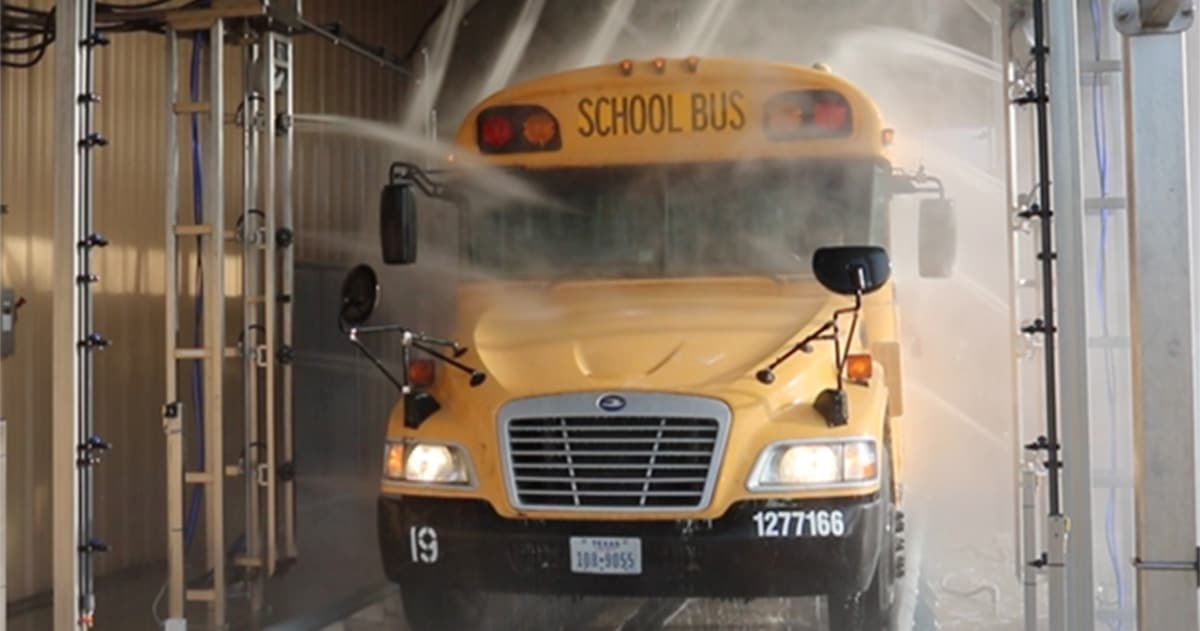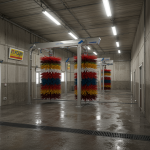Have you wondered what goes into washing a school bus? If you’re a school bus driver, an ISD operations manager, ISD transportation director, ISD purchasing agent or just curious about how this process works, today, LazrTek will answer a few of the questions you may be asking about the best way to wash your school bus fleet and ancillary vehicles or how other school systems usually do this.
We will also include a few ways to properly wash and clean the interior and exterior of a school bus if you are interested in regular detailing to keep your fleet pristine and make your equipment attractive to the public, staff, parents, and students.
How Are School Buses Washed Today?
Many school systems pay independent contractors to have their fleet of school buses washed from time to time (or pay to have them washed at a Bus washing facility), but many times this is a task performed by the school bus driver.
Many school systems actually pay bus drivers extra to wash their buses in the summer and to keep them clean throughout the year. Depending on the budget of the school system, some even have a commercial automated bus washing machine with a formal washing policy for the district as a way to prolong the life of the fleet and improve imaging. Some ISDs also have other vehicle types such as suburbans, vans, team buses, police patrol cars, etc. that utilize the automatic commercial wash system.
Automatic Bus Washing Machines
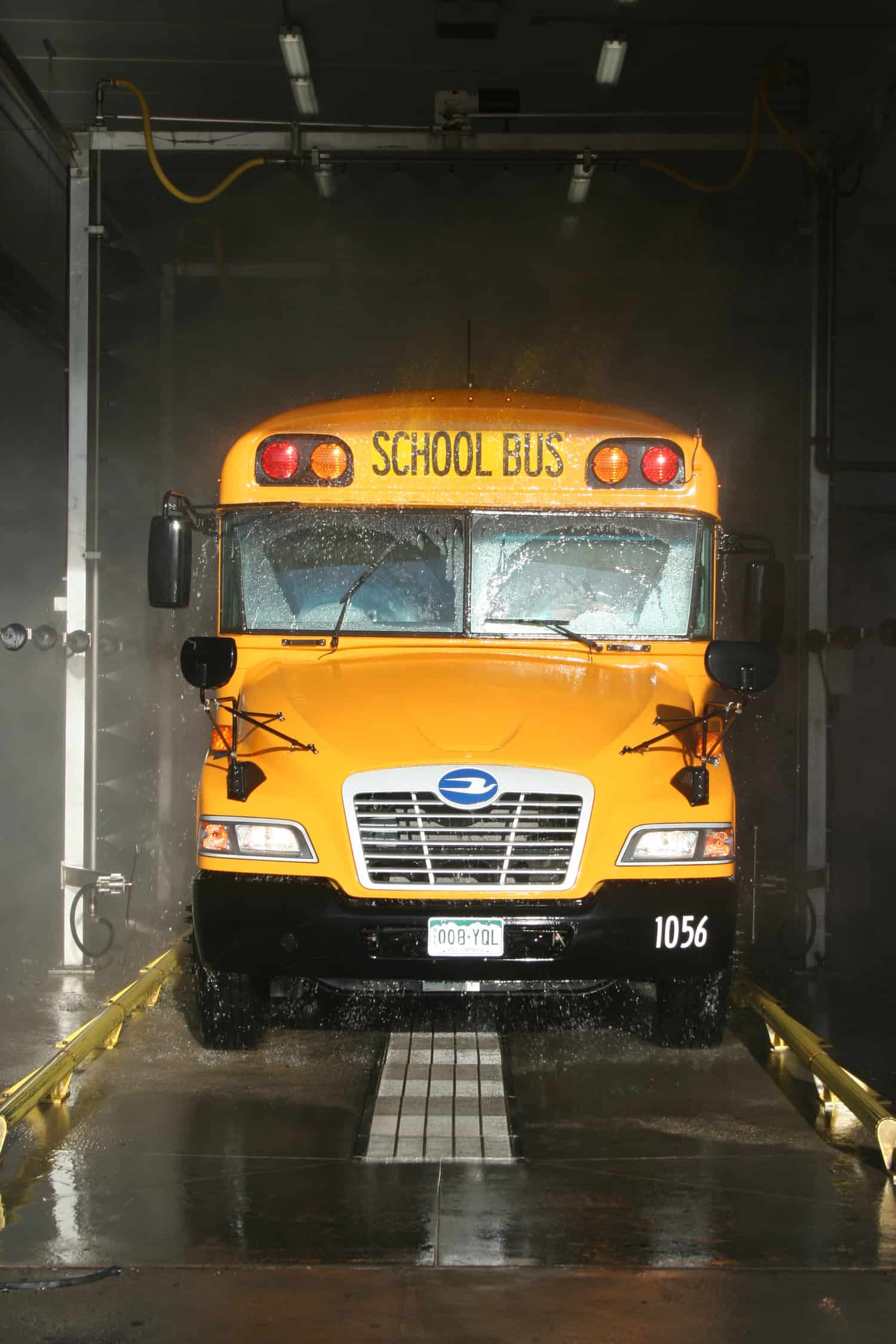
School districts that utilize automatic bus washing machines are growing in number because of acute labor shortages and general negativity to the manual labor of washing post pandemic. These automatic bus washing systems look a lot like your typical tunnel car wash or Bus wash that uses either brushes or high-pressure water nozzles to clean vehicles, but at a much larger scale and at a commercial facility where buses and vehicles are parked overnight and fueled.
The funding for a commercial automatic wash system usually comes from the school district’s transportation unit, and can be one of the first cuts to a school’s budget due to the cost of washing a large fleet.
Due to rising labor shortages, some public-school districts even rely on prisoners from the city or county jails to fulfill their public service responsibilities by scrubbing buses. Often times buses go unwashed for prolonged periods of time, and it falls on the bus driver to keep them relatively clean which can be difficult and challenging for the transportation and operations directors.
There are several important things to keep in mind if you are you looking to wash the outside and inside of a school bus.
Washing the exterior of a metal school bus – soaps, products & water pressure
Since pretty much all school buses are made of galvanized metal painted yellow, they usually oxidize rather quickly and can be difficult to wash by hand. This is why some contracted auto detailers or mobile fleet washing companies typically start with a touchless wash method called a two-step wash.
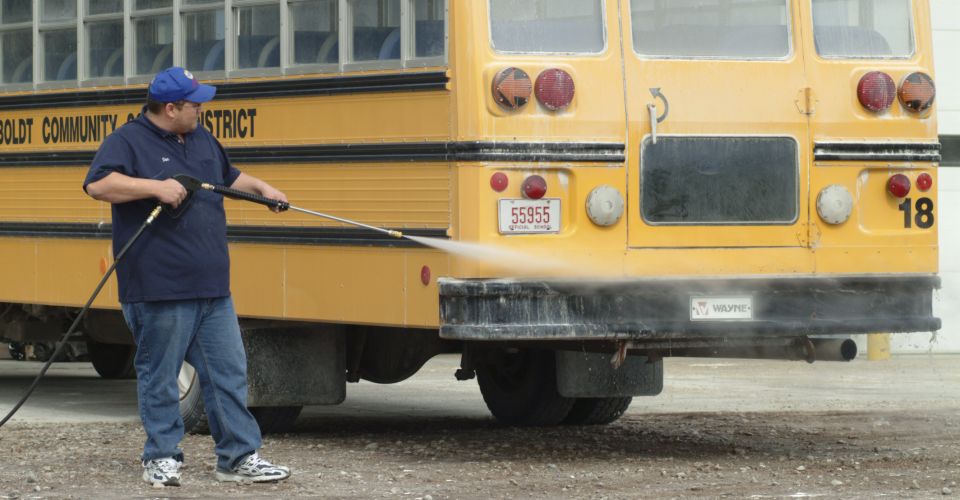
Usually, this starts with a low pH acid that helps to loosen stuck-on dirt, followed by a foamy, high pH detergent specifically designed to wash away this dirt without scrubbing – allowing the chemical reaction do all the work.
Some bus cleaners are also specifically made from chemicals formulated to remove dirt and dust-based soils. Other modern biodegradable chemical treatments work well in removing bugs and organic debris.
School Bus Cleaning Tips
Tips for washing by hand
If you are a smaller contractor or bus driver that doesn’t have access to this two-step method, most foaming soaps will do. If washing several buses, you may also want to expense a commercial-grade bus detergent that cuts through grease, soils, and oxidation that most basic car detergents simply can’t. If you want to improve on the two-step wand hand wash system consider the LazrTek mobile wash unit that allows a single operator to wash a 40’ school bus in just 6 minutes without breaking a sweat because the unit is electric and totally self-propelled.

Can you wax a school bus?
Yes, you can wax a school bus, but be careful if there is a lot of oxidation as it can remove paint if the bus is very old. One product called Color Back. This stuff is great for removing oxidation and brightening the yellow color of a dull, faded school bus.
Cleaning wheels and tires
A soapy bucket and brush are standard protocol for tires like cars, and most degreasers will do the trick for cutting through heavy grime. Many aluminum cleaners designed for semi-Buss work well if wheels are aluminum and heavily oxidized. Simply spray on the cleaner, and allow it to sit for a few minutes before rinsing.
Cleaning the interior and maintenance
If mildew is present, a water-bleach mixture can be effective, just be careful not to stain seats or other leathers and fabrics that bleach can damage. Rubbing alcohol diluted in water and mixed in a spray bottle should do the trick for removing permanent marker, and other inks or stains found on leather or vinyl seats.
Cleaning windows
For windows, cheap glass cleaners like Windex are usually the most cost-effective, but you can also use diluted rubbing alcohol (called an IPA wipedown by detailers) if there are stains or grime the glass cleaner is having a tough time cutting through.
Pine-Sol for any wooded areas is usually a safe bet as well. Usually a mild soap and water, rubbing alcohol or even white vinegar are good options for floors and other interior areas.
How to Keep Your School Bus in Pristine Condition All Year Round?

What are today’s best practices for keeping your school bus cleaner? What kinds of school bus wash equipment should you use? Need to know how to clean bus floors and other interior surfaces?
Driving kids to school day in and day out can sometimes be entertaining, but many times challenging for the School District. You’ve got to drive in all weather and keep the kids safe in all kinds of traffic while keeping the peace on the inside!
Despite the challenges of the job, the district and its drivers take pride in their bus and bus fleet and want to keep their bus in pristene condition. After all, school buses represent your school, district and your town! So, how do you keep your vehicles clean throughout the year? And what kind of bus cleaners and school bus wash methods can you use at the end of the school year for a top-to-tail wash?
We’ll suggest daily, monthly, and annual wash schedules, as well as school bus wash techniques you’ll need to establish a formal wash policy and get the job done, what cleaners to use, when you should clean, how to clean bus floors, and much more.
The Daily Sweep
To keep your bus cleaner, at the end of each run or the end of the day, walk through your bus with a bag and pick up all the loose trash. You can minimize the amount of trash left on the bus by strictly enforcing the “no eating or drinking on the bus” rule—this is the law in many states and it’s there to protect the students’ and your safety.
Once the large pieces have been collected, go through with a broom and sweep out the aisle and under the seats. A hand brush is a useful piece of school bus wash equipment for getting into difficult-to-reach corners and under the seats with the new-style curved legs.
This is all you really need to do on a daily basis unless you notice some new graffiti and want to remove it before the next day.
The Weekly Clean
This is a deeper cleaning that keeps your bus cleaner overall and makes the annual clean so much easier. For the monthly wash, you will need bus wash equipment, including:
- Rubber gloves
- Trash bag
- Wooden paint-stirring stick
- Razor blade
- Broom
- Dustpan
- Mop
- Hose
- Sponge
- Brush (for the wheels)
- Bucket of water (cold or warm)
- Car wash detergent or commercial bus cleaner
- Window cleaning solution
- Antibacterial solution (such as bleach)
- Surface cleaner for seats
- Goo remover for sticky spots
- Tire treatment if desired
- Paper towel or newspaper
- Damp cloth
- Ladder if washing the exterior by hand
You may find that some brands of bus wash equipment work better for you than others and this will take some trial and error. Here, we’ll use generic product descriptions.
Weekly Cleaning Tips: A Step-by-Step Guide
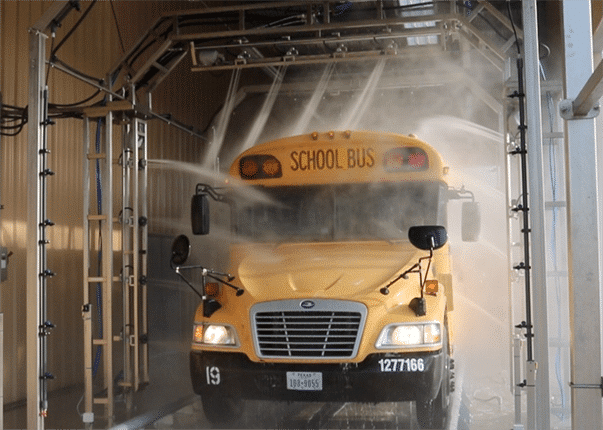
After your regular pick-up and sweep, these are the areas that will need attention in your monthly wash to keep your bus cleaner and more kid-friendly. We recommend wearing rubber gloves as part of your school bus wash equipment to avoid damaging your skin. It’s also a good idea to keep the bus windows open to air it out while you clean the inside.
Trash Between the Seat and the Bus Wall
Even though students aren’t supposed to eat or drink on the bus, packets, tissues, and the like often get stuffed in between the seat and the wall. This is easy to remove with a good old-fashioned wooden paint-stirring stick. Once removed, you can either place it in your trash bag by hand or drop it on the floor to be collected when you sweep.
Chewing Gum
Chewing gum poses more of a problem to remove with regular bus wash equipment because it’s just plain sticky! You can get chewing gum off the walls, seats, and floor with a razor blade and follow up with a goo remover if any residue is left behind.
Seats
Wipe the seat, back, and sides with a surface bus cleaner and/or general surface antibacterial solution mixed with water to remove the grime and kill the hundreds of germs that students bring on and off the bus each day. Leave this on while you clean the interior windows and then wipe it off with a paper towel or a fluff-free rag.
Avoid any sort of harsh school bus wash treatments that will ruin the seats or interior of your bus.
Mildew
In the more humid south, mildew can become a real problem and poses a health hazard for passengers. To get your bus cleaner in these environments, wipe out your bus with hot water and bleach to kill any mildew, and make sure you keep your bus windows open until it is completely dry.
Driver’s Cockpit
The driver’s cockpit tends to become coated in dust from the constant opening and closing of the door and dust blowing in from outside. To get your bus cleaner, use a vacuum, then wipe over the dashboard and instrument panel, seat, and gear stick with a damp cloth and antibacterial solution and/or a surface cleaner.
Walls, Ceiling, and Roof Hatches
Using the same solution, wipe over the walls, ceiling, roof hatches, and window ledges—spot-cleaning with a goo remover as necessary. Be careful of cameras and DVD players if using a spray bottle as part of your school bus wash equipment to clean the ceiling.
Writing on the Walls and Seats
It would be lovely if our dear passengers respected our buses as much as we do, but if someone has gotten up to mischief with a pen (or MARKER!) on the walls or seats, there is usually a way to remove it. First, try rubbing alcohol or a strong hand cleaner designed for mechanic technicians. Leave it for a few minutes and then rub it off. If that doesn’t work, you could use more powerful bus cleaner chemicals such as goo remover, oil-free makeup remover, or nail polish remover. All of these products should be safe for vinyl seats. Simply clean off any residue afterward.
How to Clean Bus Floors & Aisles
After cleaning all of the interior surfaces and windows, clean the aisle and floor. If you’re wondering how to clean bus floors most efficiently, you’re lucky if you have an older bus: Old buses can be hosed out completely, making this step quick and easy.
New buses with plywood floors cannot be hosed down, or else the floor could be damaged. Newer floors can be mopped with bus floor cleaner and water, followed by a clear liquid floor wax.
When it comes to the best practices for how to clean bus floors, the last step is the most important: Air out your bus completely. Put many if not all of the windows down, leave the door open, and run a couple of fans. Once the floor is completely dry, you can close up the bus nice and tight.
Vehicle Exterior
Now, it’s time to clean the outside. To get your bus cleaner without taking forever, hose your bus down first to remove loose dirt. Then, use a sponge or to soap up the sides and roof. You will need to use a ladder or movable stairs (as safely as possible) to reach the roof. (We highly recommend adding movable stairs to your school bus wash equipment, if you don’t have a raised platform.)
As for the particular chemicals and bus cleaners you should use: Car detergent works much better than ordinary dish detergent. When you’re done, hose the bus down again to rinse.
Highly motivated bus drivers might even like to finish by waxing their bus for that A+ finish!
Wheels and Tires
To wash the wheel wells and tires, use a brush and some soapy water. You can apply a tire treatment from a bus wash equipment store at the end to make the rubber shine.
Windows and Mirrors
Windows can be washed daily if you really want your bus to shine; otherwise, once a month is generally sufficient. This is something that will depend on the weather where you live and whether your route includes dusty, unmade roads. But there’s no denying that frequent window-washing makes a bus cleaner-looking in appearance by far!
With your school bus wash equipment, spray your windows and mirrors with a window cleaner, leave for the amount of time recommended on the bottle, and then dry with a paper towel or newspaper. Rags tend to cover the windows in fluff, but if you have a fluff-less rag, this is also a good option.
Exterior window cleaning is generally the last step in the bus wash process to avoid making them dirty again.
Don’t forget to clean the window interiors as well: Kids smudge them constantly with their hands and faces.
At the End of the School Year
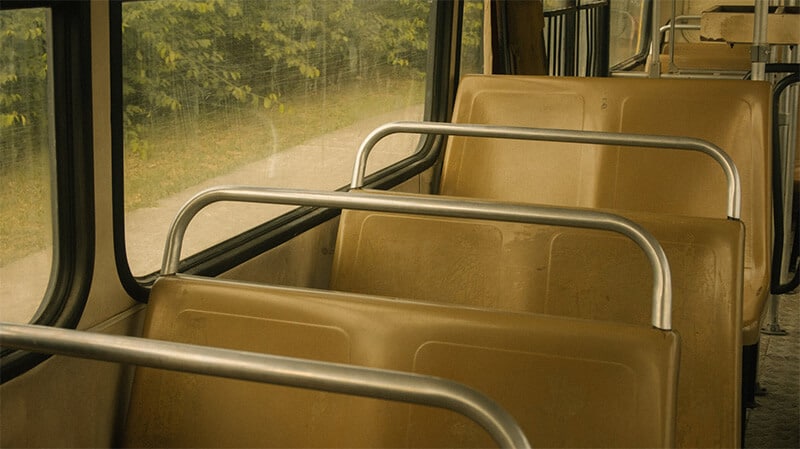
Keeping your bus cleaner during the school year is vital, but it’s just as vital to do a thorough cleaning before going into the off-season. Before heading off for the summer, you will need to do a complete bus cleaning with specialty school bus wash equipment before parking your vehicle back at the depot. This is especially important if your bus is going to be turned in and replaced.
First, perform your monthly bus clean, paying great attention to detail. Then add the following two steps:
Take Down Flyers & Notices
Any notices you put up during the year will need to be taken down and the residue cleaned with goo remover or window fluid. These might include:
- “Bus rules” signs
- “No eating or drinking” signs
- Timetables and schedules
- Funny, cheery posters that you’d put up for fun
- Anything else affixed to the windows and ceiling
Removing these materials annually will help keep your bus cleaner in appearance and discourage vandalism by the kids.
If you’re wondering how to clean bus floors with papers or other matter stuck to them, the process is pretty similar, although the floors can potentially take a heavier-duty chemical bus cleaner if needed. Strong solvents such as acetone are great for dissolving caked-on glue and are also good for removing superficial scratches (where the bus surface isn’t actually damaged, and the scratch comes from material deposited by whatever object came into contact with it). Don’t use products like acetone on paint or plastics, or, if you must, wash them off very quickly afterward.
Remove Personal Belongings
Once you’ve taken everything down, search through the entire bus (and especially the driver’s area) and remove all of your personal belongings. Put your things in a bag to take home and vacuum and wipe out all of the compartments. Now you’re done and you’ve gotten your bus cleaner than ever before!
The Easiest Solution with LazrTek Bus Wash Systems
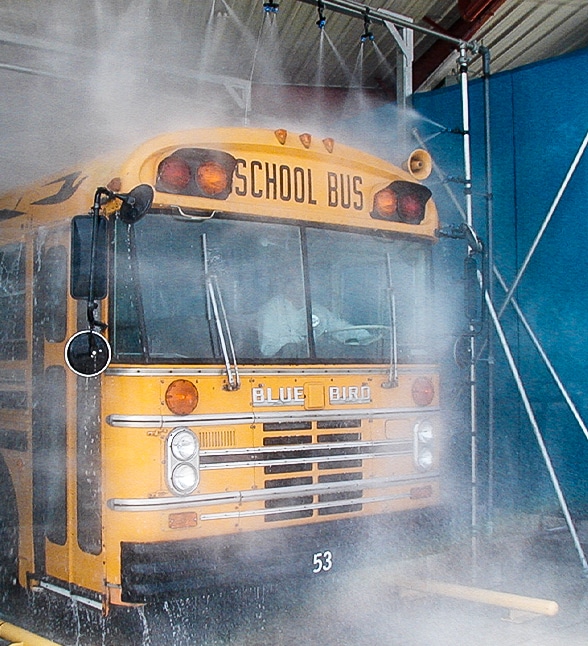
Looking for school bus wash systems? At LazrTek, we are innovators who are constantly looking to develop more effective and lower-maintenance bus cleaning solutions. School bus provider might be interested in considering our bus wash systems for a quick and easy solution that keeps the entire fleet in tip-top shape!
We hope this has given you a good sense of best practices for getting your school bus cleaner. Now you have a better sense of how to clean bus floors, windows, aisles, and exteriors! Contact us to learn more about our bus cleaning solutions.
LazrTek Bus Wash System Comparison
Automated Touchless Drive-Thru Bus Wash vs. Touchless Gantry Computer-Lazer-Profiling Wash System vs. Traditional Gantry Brush Wash
Automated Touchless Drive Thru Bus Wash
Positives:
- A drive thru bus wash delivers a good wash product with minimal maintenance costs and limited down-time. In fact, LazrTek provides all parts and labor for repairs in the touchless drive through wash contract.
- A LazrTek Touchless Drive thru system is designed to have the fewest number of moving parts possible which cuts down-time and maintenance.
- We do not support our business by billing for service, but by word of mouth about how reliable and maintenance-free our wash systems are and how clean we get the buses.
- It takes approximately 2 ½ min. to completely wash a 40’ Bus. You can wash many vehicles in a single day
- Drivers won’t be sacrificing their road time waiting in line to get their vehicle washed
- Waits for a drive thru wash are rare due to their inherent efficiency.
- All types of Buss and trailers get a complete clean from top to bottom without the need for brushes.
- A drive thru is safer for the driver because they aren’t walking along a soapy and wet surface and never have to get out of the bus. The drivers never need to exit their vehicles while in the wash bay.
- Drivers move through the wash at approximately 1 foot per second (Creeper gear). There are also guide rails to prevent the driver from steering their vehicle into the wash gear.
- Drivers are guided through the wash using our Smart Driver Pace Light System. This utilizes High Intensity LED lights to ensure they are moving at the proper speed. Most drivers are using a wash to get their Bus and trailers clean and will move at the proper speed to ensure this happens.
- They can be installed in most buildings where a Gantry style wash has been installed or may be utilized outdoors without a building. A cover is recommended to ensure rainwater does not mix with biodegradable chemicals and soaps.
- Approximately 30% of our new business comes from bus fleet management companies swapping out their Gantry washes and replacing them with a touchless drive thru or touchless profiling Gantry.
- We are consistently able to utilize the same building or concrete driveway their previous wash was housed.
- A drive thru Bus wash can be 100% customized to address the fleet owner’s needs and wash policy.
- Our touchless drive-through wash systems typically reduce labor by at least 2/3rds
- Touchless drive thru wash systems use less chemical, soap and water (1/3 to 2/3rds less) than a traditional brush Gantry or 2-step hand wash wand system.
Negatives:
- The quality of the wash can be slightly affected by drivers who ignore smart pacer lights & drive too fast through the wash.
- Drivers typically want their Bus clean and will use the smart driver pace lights, once comfortable to ensure a proper wash.
- The first time a driver goes through a drive-thru wash, the high-intensity, high-pressure, low water volume rinse portion can be slightly disorienting.
- Customarily, the second time through the wash, this feeling dissipates. The more drivers use the wash, the more comfortable they will become.
Touchless Gantry Computerized-Lazer Guided 3D-Profiling Wash System
Positives:
- A touchless gantry-computerized profiling wash consumes limited space due to its compact size.
- It does a good job of cleaning a Bus with irregular surfaces utilizing computerized automatic Laser guided profiling automation keeping the jets consistently 18 inches from all surfaces.
- The computerized 3D profiling system allows exact distance nozzle directions to wash multiple sizes and shapes of vehicles from automobiles, trucks, tractor trailers, buses, RVs, Vans, and heavy equipment.
- It will always wash at the same speed, versus the variable rate of pressure washing.
- It will provide a consistent wash.
- A touchless Gantry is safer for the driver because they aren’t walking along a soapy and wet surface to walk to a lobby. The drivers never need to exit their vehicles while in the wash bay.
- Uses less chemical, soap and water (1/3-2/3rds less) than a traditional brush Gantry or 2-step wand handwash.
Negatives:
- Touchless computerized 3-D profiling/mapping Gantry washes take an extra minute or two for the computer to profile the vehicle before washing, therefore average wash time is about 6 minutes.
Traditional Brush Wash System (Traditional Gantry)
Positives:
- A gantry-style wash brush wash consumes limited space due to its compact size.
- It does a good job of cleaning a Bus, especially a school bus because low pressure pumps are utilized which limits water leakage through windows and bus body riveted body joints.
- It will always wash at the same speed, versus the variable rate of pressure washing.
- It will give you a consistent wash resulting in a very clean bus.
Negatives:
- Brush Gantry washes have greater maintenance costs due to all of the moving parts that are required to operate it.
- It takes approximately 10 min. or more for a driver to complete an entire wash which cuts utility and may interrupt bus schedules.
- There are a limited number of Bus and trailers you can wash per day.
- There may be additional detailing time if the initial wash did not clean irregular surfaces
- Drivers sacrifice valuable road time waiting to use the wash and waiting for a wash to complete.
- Irregularly shaped Buses are practically impossible to clean with a traditional gantry wash.
- Non-typical shaped buses and the backs of tractor cabs will never be fully cleaned without using manual labor and a pressure washer because the brushes cannot reach every spot on the bus such as behind the mirrors. This is the reason pressure washers are sold and installed with all gantry brush systems.
- Brushes sometimes create micro-abrasions on a bus surface. Micro-abrasions dull paint surfaces more quickly and speeds up the deterioration of clear coat and any decals and/or image wrapping on a vehicle.
Conclusion
If you’re in charge of cleaning school buses at your district or considering washing fleets of buses, it really does help to use LazrTek bus wash system and use a cleaning method that doesn’t require scrubbing if you can help it.
That being said, if you only have ten school buses to wash at a small elementary school, using a brush with an extendable handle will obviously do a better job at removing stuck on substances that soap can’t, but a two-step type of wash is the most efficient way for washing large fleets.
LazrTek, in association with its Joint Venture partner, Envirochem is collectively one of the largest automated touchless school bus washers in the United States and the largest in the state of Tennessee. Let LazrTek advise you on the best way to solve your school bus fleet washing problems with a fast, low priced, convenient touchless wash system that your bus drivers and vehicle operators will enjoy and actively participate in your wash policy. Contact Harold@LazrTek.com or call (469) 536-8478.
